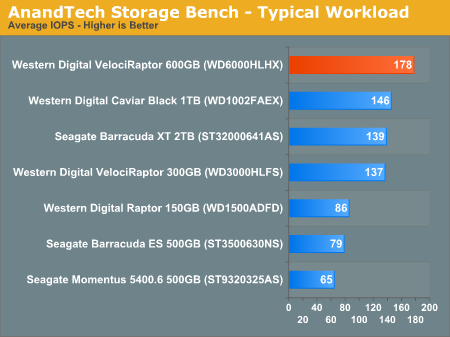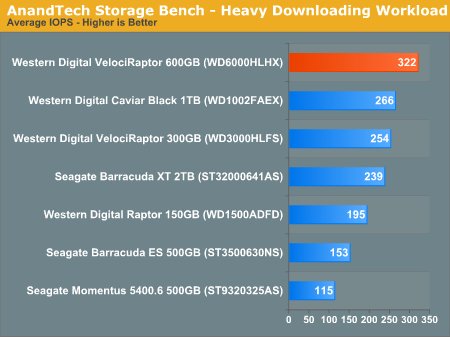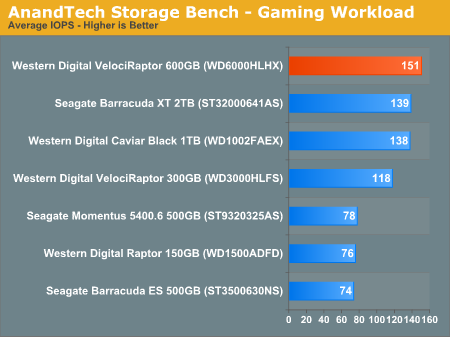Western Digital's New VelociRaptor VR200M: 10K RPM at 450GB and 600GB
by Anand Lal Shimpi on April 6, 2010 8:00 AM EST- Posted in
- Storage
AnandTech Storage Bench
The first in our benchmark suite is a light usage case. The Windows 7 system is loaded with Firefox, Office 2007 and Adobe Reader among other applications. With Firefox we browse web pages like Facebook, AnandTech, Digg and other sites. Outlook is also running and we use it to check emails, create and send a message with a PDF attachment. Adobe Reader is used to view some PDFs. Excel 2007 is used to create a spreadsheet, graphs and save the document. The same goes for Word 2007. We open and step through a presentation in PowerPoint 2007 received as an email attachment before saving it to the desktop. Finally we watch a bit of a Firefly episode in Windows Media Player 11.
There’s some level of multitasking going on here but it’s not unreasonable by any means. Generally the application tasks proceed linearly, with the exception of things like web browsing which may happen in between one of the other tasks.
The recording is played back on all of our drives here today. Remember that we’re isolating disk performance, all we’re doing is playing back every single disk access that happened in that ~5 minute period of usage. The light workload is composed of 37,501 reads and 20,268 writes. Over 30% of the IOs are 4KB, 11% are 16KB, 22% are 32KB and approximately 13% are 64KB in size. Less than 30% of the operations are absolutely sequential in nature. Average queue depth is 6.09 IOs.
The performance results are reported in average I/O Operations per Second (IOPS):

Performance in our real world benchmark however makes it very clear that no other hard drive is as fast as the 600GB VelociRaptor. WD delivers a nearly 30% improvement over the old drive, and 22% better performance than the new Caviar Black series.
If there’s a light usage case there’s bound to be a heavy one. In this test we have Microsoft Security Essentials running in the background with real time virus scanning enabled. We also perform a quick scan in the middle of the test. Firefox, Outlook, Excel, Word and Powerpoint are all used the same as they were in the light test. We add Photoshop CS4 to the mix, opening a bunch of 12MP images, editing them, then saving them as highly compressed JPGs for web publishing. Windows 7’s picture viewer is used to view a bunch of pictures on the hard drive. We use 7-zip to create and extract .7z archives. Downloading is also prominently featured in our heavy test; we download large files from the Internet during portions of the benchmark, as well as use uTorrent to grab a couple of torrents. Some of the applications in use are installed during the benchmark, Windows updates are also installed. Towards the end of the test we launch World of Warcraft, play for a few minutes, then delete the folder. This test also takes into account all of the disk accesses that happen while the OS is booting.
The benchmark is 22 minutes long and it consists of 128,895 read operations and 72,411 write operations. Roughly 44% of all IOs were sequential. Approximately 30% of all accesses were 4KB in size, 12% were 16KB in size, 14% were 32KB and 20% were 64KB. Average queue depth was 3.59.

Upping the number of writes doesn't change anything, the new VR is 26% faster than the old one and 21% faster than the best 7200 RPM drives. Keep in mind this is pure I/O performance, the real world performance is most likely in the 3 - 10% range on average which is what we saw in PCMark Vantage and SYSMark 2007.
The gaming workload is made up of 75,206 read operations and only 4,592 write operations. Only 20% of the accesses are 4KB in size, nearly 40% are 64KB and 20% are 32KB. A whopping 69% of the IOs are sequential, meaning this is predominantly a sequential read benchmark. The average queue depth is 7.76 IOs.

Sequential read performance is solid on the new VR, but not that much better than other, larger (and cheaper) drives on the market. Western Digital's advantage over the old VR is a healthy 27%, but over newer 7200 RPM drives it's barely 9%.










77 Comments
View All Comments
vol7ron - Tuesday, April 6, 2010 - link
Agreed, it could be done, but it would also cause more confusion when you could see data in one place, but not in another. Not to mention, it's probably easier not to have to worry about it from an editor's standpoint - a bad excuse, but probably true.vol7ron
Muon - Tuesday, April 6, 2010 - link
Skewing the graphs is a ludicrous argument not to include SSD in the test. Why not use a logarithmic scale? I guess maybe people in the USA are too dumb to understand such graphs and would think the performance difference is much smaller then it really is.Earthmonger - Tuesday, April 6, 2010 - link
What would be the point of including SSD results?Would you compare a horse and buggy to a turbo-diesel 18-wheeler?
A wax candle to a halogen headlamp?
HotFoot - Tuesday, April 6, 2010 - link
People aren't really selling oxen and wagons to compete with 18-wheelers, whereas the Raptor here is a new product brought into the high-performance storage for desktops market. It certainly is competing against SSDs or a combination of SSD+HDD.I think the general consensus is if you're wanting a lot of performance in a desktop, you'd do better to take the $330 and buy an 80 GB SSD and a 1 TB HDD. I think, given it's about the same price for nearly double the storage capacity, it's be a VERY interesting combination to see on the performance charts.
This entire article basically starts out with the understanding that the new Raptors were obsolete before they ever launched to market.
+
Anand Lal Shimpi - Tuesday, April 6, 2010 - link
The assumption here is someone who wants a VelociRaptor for whatever reason has already ruled out an SSD. If I threw in SSD results it'd be very difficult to make comparisons between the VR and other hard drives as they'd get compressed in the chart.In the not too distant future we'll allow cross technology comparisons between HDDs and SSDs in Bench, but until then I figured just pointing folks at Bench if they wanted SSD results would suffice.
Take care,
Anand
jimhsu - Wednesday, April 7, 2010 - link
Not exactly. Even using this drive in lieu of a SSD for a boot drive is "stupid" (which I think it is), people with hundreds of gigabytes of Steam games or such simply aren't satisfied with the performance of a 1 TB drive. Putting 500 GB of games on SSD is ... expensive. Plus as I have shown in some forum posts, *most* modern games aren't so sensitive to random read/write rates anyways, so the benefit of a SSD is less than for general apps. (MMORPGs, particularly WoW in my testing, are a very clear exception)vol7ron - Tuesday, April 6, 2010 - link
@Muon:
"Skewing the graphs is a ludicrous argument not to include SSD in the test."
I'm guessing most figures from these tests are not done all at once. The charts are more likely a compilation of all the singular tests for that product, for that test bed. Meaning one test may have been run a month ago. Therefore, the SSDs are included in the tests, the results are just posted someplace else. -- go check the storage bench
"Why not use a logarithmic scale?"
Charts are included to have something visible and simple, not something you want to have think about to understand what it represents - that's the whole idea of chart vs table. Bar graphs are perfect because they are proportional and are able to list quanity, rather than a power or base of that quanity. Additionally, how would propose introducing a logarithmic chart - instituting a trendline? - if you take each value to the same base log, you're going to have the same problem with scale, and if you're using the trendline, your graph may be relational, but it will be also be visually innacurate for this type of data.
"I guess maybe people in the USA are too dumb to understand such graphs and would think the performance difference is much smaller then it really is."
That may be. Again, you'd be losing the quick-glance feature of the charts. Not to mention, AT probably has some simple charting software (or macros) that they use, which would need to be changed. If something is so much different, it's not worth including or modifying the portion of your chart. SSDs are in a league of their own and therefore have their own charts - HDDs are included in them because they won't skew the SSD chart AND the value doesn't need to be legible, all that needs to be seen is that the HDDs are insignificant. Because this particular value is about HDDs, the visual true-value comparison is necessary. You would not get that if an SSD was present.
vol7ron
vol7ron - Tuesday, April 6, 2010 - link
I'm just curious what the Windows index rating is. I know that doesn't really account for anything, but I like looking at that, for some awful reason.RaistlinZ - Tuesday, April 6, 2010 - link
I can buy two Samsung Spinpoint F3 1TB drives ($180.00) and put them in RAID 0 and get way more performance, and way more storage space, for 2/3 of the price of the 450GB Raptor. So what's the point of these Raptors exactly? I still don't see where they fit in.Fastidious - Tuesday, April 6, 2010 - link
Yeah, they seem pointless. I never understood why people buy them. With SSD around now it's just that much worse.